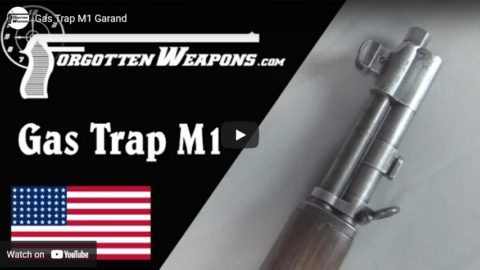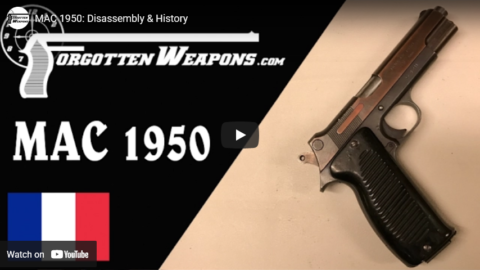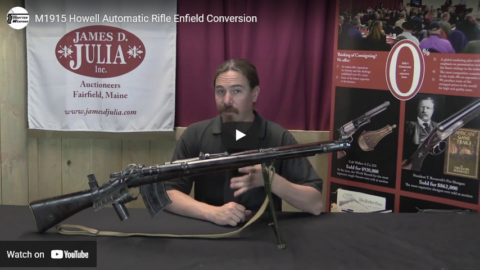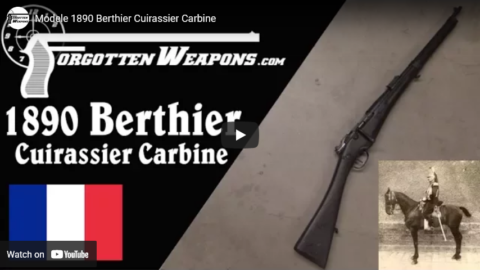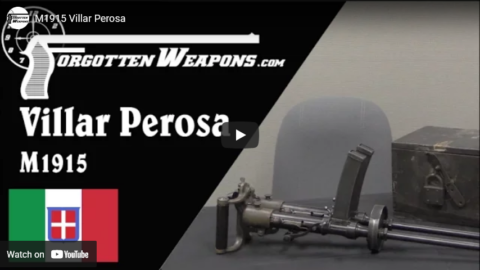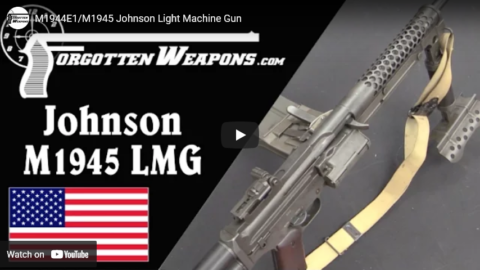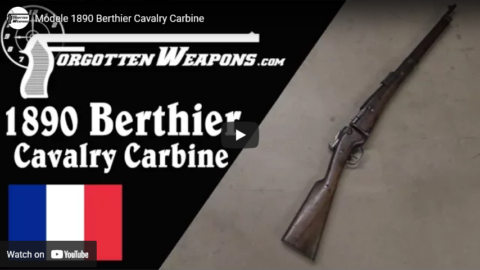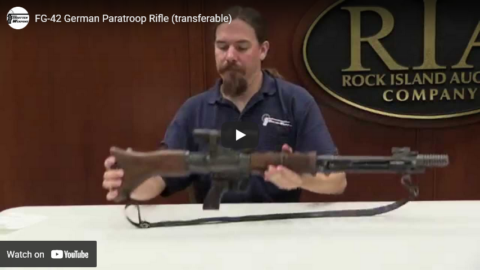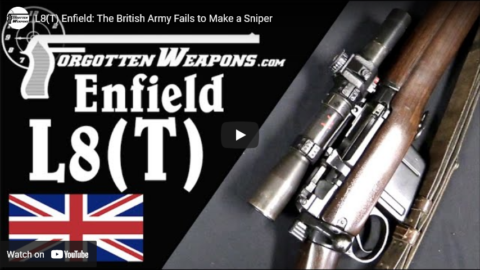Forgotten Weapons
Published 29 Sep 2016Cool Forgotten Weapons Merch! http://shop.bbtv.com/collections/forg…
The original design of the M1 Garand as adopted in 1936 used a “gas trap” system instead of a gas port drilled in the barrel. This system used a type of muzzle cap and false muzzle to redirect gas into the gas cylinder in the short distance between the end of the rifled barrel and when the bullet left the muzzle. The system worked, but was not ideal.
Several problems were found with the gas trap system as the guns went into production. These included cleaning complexity, an unstable front sight, and a potentially weak bayonet mounting point. Most significantly, however, one rifle in testing had a screw work loose in the muzzle cap, which allowed parts to shift out of alignment and resulted in a bullet striking the gas plug and blowing the entire assembly off the gun. This led to a decision to redesign the gas system of the M1 to use a simpler gas port drilled in the barrel.
When this design change was made, 18,000 rifles had been completed and parts were made for an additional 33,000. Those guns were completed with the available parts, and the new gas system was used for all further production. Gas trap M1s are very rare today because the guns were updated to the new system when they were overhauled during WWII, and in 1947 the Army ordered all remaining gas trap rifles destroyed.
June 11, 2022
Gas Trap M1 Garand
June 8, 2022
MAC 1950: Disassembly & History
Forgotten Weapons
Published 27 Feb 2017Shooting the MAC 1950: https://www.youtube.com/watch?v=sduZ4…
The PA MAC 1950 (Pistolet Automatique Modele 1950) was the result of a 1946 French effort to standardize on a single military pistol. By the end of WWII, the French military had accumulated a mess of different pistols of French, Spanish, American, and German origin; officially using the Luger, P38, Mauser HSc, 1911 (and A1), 1935A, 1935S, Star, Ruby, and Model 1892 revolver.
Trials were held in 1950, although the outcome was predetermined — this pistol, designed by St Etienne and largely derived from the Model 1935S, was to be the next French military sidearm. A design from the SACM company was also tested, as was a commercially purchased SIG SP47/8, but this was for comparison sake only. In fact, the SIG was the best performer in the testing, with the St Etienne design suffering from cracked parts and durability problems. It would be improved, however, and deemed suitable for adoption by early 1951.
Production began in 1953 at the Chatellerault arsenal (hence the “MAC” name used in the US). All of 221,900 were made by Chatellerault until it was shut down in 1963, when production transferred to St Etienne, where another 120,000 would be made by 1978.
Mechanically, the gun is largely taken form the Browning 1911, with a few improvements. The recoil spring is of a captive design, and the fire control group is all built into a single easily replaced unit (similar to the Tokarev and the 1935S). It is single action only, with hammer-block and magazine safeties and a 9-round magazine of standard 9x19mm ammunition. It is still in French service, having proven to be a reliable and dependable weapon, if outdated by today’s standards.
http://www.patreon.com/ForgottenWeapons
Cool Forgotten Weapons merch! http://shop.bbtv.com/collections/forg…
If you enjoy Forgotten Weapons, check out its sister channel, InRangeTV! http://www.youtube.com/InRangeTVShow
June 5, 2022
Winchester G30M
Forgotten Weapons
Published 27 Jul 2016http://www.patreon.com/ForgottenWeapons
With the death of Jonathan “Ed” Browning in 1939, development of the Winchester G30 rifle was passed into the hands of a new employee at Winchester by the name of David Marshall Williams. Williams would become widely known as “Carbine” Williams in later years thanks to Jimmy Stewart and Hollywood, but we will get to that part of the story later.
What Williams did to the G30 was to replace Browning’s annular gas piston with his own short stroke tappet system (this being the first rifle to use that system of Williams’). This substantially improved the gun’s reliability, and Winchester was able to submit it to Marine Corps trials in 1940 alongside the Garand and Pedersen rifles under the designation G30M. The Marine Corps was legitimately interested in the G30M, as it was expected to be both faster and cheaper to manufacture than the Garand.
Ultimately the trials were won by the Garand, with the G30M placing third in total malfunctions and broken parts. This had involved 37 different tests and more than 12,000 rounds through each rifle. The Garand had 1,480 total malfunctions and 49 parts broken, replaced, or repaired. The Johnson had 1,547 and 72 respectively, and the G30M 2,864 and 97 (roughly double the number of problems as the Garand).
Despite this failure, Winchester was encouraged to continue working on the rifle, if for no other reason than the possibility of foreign purchasers. Williams’ next step would be to replace the Browning tilting bolt with a Garand-type rotating bolt, which would result in a rifle Winchester would call the M2, or “the seven and a half pound rifle”. We will examine that rifle in the next video …
June 2, 2022
M1915 Howell Automatic Rifle Enfield Conversion
Forgotten Weapons
Published 28 Mar 2017The M1915 Howell Automatic Rifle is a conversion of a standard No1 MkIII Lee Enfield rifle into a semi-automatic, through the addition of a gas piston onto the right side of the barrel. Despite its very steampunk appearance, the Howell is actually a quite simple conversion mechanically. The rifle action had not been modified at all, and a curved plate on the end of the gas piston is used to cycle the bolt up, back, forward, and down just as it would be done manually.
The additional metal elements added to the gun are there to prevent the shooter from inadvertently getting their hand or face in the path of the bolt. The crude tubular pistol grip is necessary because the shooter’s hand on the wrist of the stock would normally be in the path of the bolt’s travel. Note that the Parker-Hale bipod on this example is a non-military addition from its time in private ownership.
In addition to these elements, the Howell has been fitted with a 20-round extended magazine to better exploit its rate of fire. However, the Howell was made as a semiautomatic rifle only, and not fully automatic. It was offered to the British military circa 1915, but never put into service. Instead, the British would significantly increase production and deployment of Lewis light machine guns. Howell would offer his conversion in basically the same form to the military again at the onset of World War 2, but was again turned down.
Shooting the Howell was remarkably successful — I had expected it to be very malfunction-prone, but in fact it ran almost completely without fault. In retrospect, I would attribute this to the simplicity of its conversion, which made no changes to the feeding and extraction/ejection elements of the SMLE. The gun was a bit awkward to hold, and the offset sights left one with really no cheek weld at all, but recoil was gentle thanks to the gas system’s function and added weight. Quite a remarkable gun, and one I am very glad to have been able to shoot.
http://www.patreon.com/ForgottenWeapons
Cool Forgotten Weapons merch, including this shirt specifically about the Howell! https://shop.bbtv.com/collections/for…
If you enjoy Forgotten Weapons, check out its sister channel, InRangeTV! http://www.youtube.com/InRangeTVShow
May 28, 2022
Modele 1890 Berthier Cuirassier Carbine
Forgotten Weapons
Published 17 Jul 2017http://www.patreon.com/ForgottenWeapons
When the Modele 1890 Berthier carbine was adopted for the French cavalry, the decision was made to produce a special version for the Cuirassier troops. These were the elite heavy cavalry, equipped with steel breastplates and elaborate plumed helmets. They existed in that very brief window where the worlds of Napoleon and the smokeless-powder rifle coexisted.
The armor worn by the Cuirassier required some special adaptations to their firearms, specifically to the stocks. The scaled chinstrap of the helmet interfered with a normal cheek weld to the carbine, so the comb was removed from the stock. The metal buttplate also was a poor match for the metal cuirass, as it was difficult to hold the gun in position to aim. To account for this, a leather buttplate was used on these carbine, which would be much less slippery on armor.
Aside from these changes to the stock, the carbine was identical to the standard 1890 cavalry carbine. A total of 20,000 Cuirassier carbines were made in 1891 at the Chatellerault arsenal, and few survived World War One. By fairly early in 1915 the cavalry units had been repurposed as infantry, and the Cuirassier went into the trenches with the armor and carbines — perhaps better equipped, ironically, than the infantry in the greatcoats, kepis, and with Lebel rifles.
Thanks to Justin for finding this rifle for me!
If you enjoy Forgotten Weapons, check out its sister channel, InRangeTV! http://www.youtube.com/InRangeTVShow
May 25, 2022
M1915 Villar Perosa
Forgotten Weapons
Published 5 Aug 2016http://www.patreon.com/ForgottenWeapons
The Villar Perosa is one of the first small machine guns developed and used by a military force. It was designed in Italy and introduced in 1915 as an aircraft weapon, to be used in a flexible mount by an airplane’s observer. The gun consists of two independent firing actions mounted together. Each fires from an open bolt as a rate of 1200-1500 rounds/minute, feeding from a 25 round magazine of 9mm Glisenti cartridges. This allowed the maximum possible volume of fire in an aerial combat situation, where in 1915 ballistic power was not particularly important.
As aircraft armaments improved and synchronized, belt-fed machine guns became practical, the Villar Perosa was quickly made obsolete in aerial use. The Italian military experimented with several applications of the weapon in ground combat, including slings and belt fittings for walking fire, tripods, mounts with integral armor shields, and bicycle mounts. None of these proved particularly successful, as the elements that made the gun well adapted to early aerial use (high rate of fire with a small cartridge) made it relatively ineffective for infantry use.
Ultimately, the best use of the Villar Perosa was to break them up and convert the actions into shoulder-fired submachine guns. Designs to do this were developed by both the Beretta company and Villar Perosa themselves, and in 1918 these guns entered service in the same approximate period as the first German MP-18 submachine guns. Because of this recycling, intact M1915 Villar Perosa guns are quite rare today.
May 21, 2022
Ed Browning’s Winchester G30 Prototypes
Forgotten Weapons
Published 25 Jul 2016http://www.patreon.com/ForgottenWeapons/
After Jonathan Edward “Ed” Browning had his 1929 rifle dropped from US military testing, he took the design back to his shop in Utah and kept working on it. By 1938 he had made enough improvements that he was ready to present the gun to Winchester, hoping they would be interested in purchasing the design. Specifically, he redesigned the receiver to move much of the bolt travel into the wrist of the stock, shortening the action. He also replaced the short recoil action with an annular gas piston. He made two sample rifles, one in military configuration and one in sporting configuration.
Winchester was looking for a self-loading rifle to market at the time, because they could see that war in Europe appeared to be imminent. They had been caught without a military rifle of their own during World War One, and did not want to be in that situation again. They thought that Ed Browning’s design showed merit, so they agreed to purchase it, and brought Browning onboard to help continue development.
With Winchester’s resources, it was possible to make the guns more professionally. Winchester designated the rifle the G30, and we have one of the examples made by Winchester in the video as well.
The tilting bolt mechanism took inspiration from John Moses Browning’s 1911 pistol, and the trigger housing bears an interesting resemblance to that of the French Berthier rifles (which may or may not be coincidental). The rifles appear to have worked reasonably well, although the annular gas piston was a hindrance which Browning apparently was unwilling to abandon. With his death in 1939, the project moved on to a new phase with David Marshall Williams taking on the job of improving it.
May 18, 2022
L119A2: The New British SOF Rifle
Forgotten Weapons
Published 24 Jan 2022http://www.patreon.com/ForgottenWeapons
https://www.floatplane.com/channel/Fo…
Cool Forgotten Weapons merch! http://shop.forgottenweapons.com
Around 2013, the UK MoD began looking for a new rifle to replace the Special Forces’ L119A1. Those A1 rifles were getting old, and something new was needed — and there was some thought that a new rifle could improve on some shortcomings of the A1 model. The new rifle was produced by Colt Canada (formerly Diemaco), and it was procured in both 10″ and 15.7″ barrel lengths (note that the rifle in this video has a 16″ barrel to avoid being an SBR).
The most distinctive feature of the new L119A2 was the licensed LMT monolithic upper receiver. This was used because it allowed solid mounting of devices like lasers on the side rails. However, it had major shortcomings in terms of heat retention and cleanability. The A2 also now used a MagPul CTR stock, and Geissele triggers (an excellent improvement from the A1’s MILSPEC trigger). The same Surefire suppressors were used, as were the optics from the A1s — the new A2 tender did not include new optics (nor funding for them).
Very few photos are known showing the L119A2. It came into service around 2016 or 2017, and entered public awareness after Christian Craighead was photographed using one in the Nairobi Westlands mall siege in 2019.
Contact:
Forgotten Weapons
6281 N. Oracle 36270
Tucson, AZ 85740
May 14, 2022
UK Special Forces’ M16 Variant: the L119A1
Forgotten Weapons
Published 21 Jan 2022http://www.patreon.com/ForgottenWeapons
https://www.floatplane.com/channel/Fo…
Cool Forgotten Weapons merch! http://shop.forgottenweapons.com
—
UPDATE: One correction to make; this rifle has the A2 charging handle. The original A1 version was essentially identical to the standard conventional charging handle. Sorry!
—In 1999, the UK Ministry of Defense put out a tender for a new rifle for UK Special Forces (UKSOF). The elite units of the British military were definitely not going to be using the L85! There was some competition (including the SIG 550 series), but it was pretty much known going in that the contract would be going to Diemaco (later Colt Canada) for a version of their C8 SFW (“Special Forces Weapon”). That was the case, but only after very extensive trials, which actually cost more than the procurement contract itself. The rifles were tested in all environmental extremes, including Alaska, Kuwait, and Brunei.
The rifle ultimately adopted had a number of unique features. It was at heart a Diemaco C8, with Diemaco’s early flat top upper (which predates Picatinny adoption, and is actually a bit closer to Weaver — but still compatible with modern accessories). Two barrel lengths were purchased, 10.0 inch and 15.7 inch. Other details include:
Stepped buffer tube
Textured telescoping stock
Permanently attached rubber buttplate
Lone Star grip
Knight’s RAS with locking clamps on both top and bottom rails
Strengthened gas block (usually but not always)
SureFire 216-A flash hider
Unique castle nut details
Ambidextrous charging handleThe barrel profile chosen for the L119A1 is quite heavy, and the 10 inch barreled version is substantially overgassed. The guns were heavy, but very reliable, and have since been adopted as the standard service rifle of the Royal Marines. The SOF opted to seek out a replacement around 2013-2016, and that would result in the L119A2 (a significantly different rifle).
Contact:
Forgotten Weapons
6281 N. Oracle 36270
Tucson, AZ 85740
May 11, 2022
M1944E1/M1945 Johnson Light Machine Gun
Forgotten Weapons
Published 27 Aug 2016http://www.patreon.com/ForgottenWeapons
After getting his Model 1941 machine gun purchased in small numbers by the US military, Melvin Johnson continued to press for more sales and a general adoption. Following testing results and recommendations from soldiers in the field, he made a number of modifications to the gun and developed the M1944, which was quickly tweaked to become the M1944E1, also called the M1945. This new version included several improvements including:
* Replacing the bipod with a monopod less prone to interfering with barrel removal
* Improved stronger bolt anti-bounce latch
* Metal dual-tube buttstock in place of wood
* and most significantly, a gas-boosted hybrid recoil operating systemThis new model of the Johnson was in testing at the end of WWII, and weapons development budget cuts at the conclusion of the war prevented it from replacing the BAR as Johnson and many in the Marine Corps had hoped.
This particular M1945 Johnson is fully transferrable, as came out of the Winchester Museum Collection (now the Cody Firearms Museum) back many years ago when curators would occasionally sell items from the collection to raise money.
May 7, 2022
Modele 1890 Berthier Cavalry Carbine
Forgotten Weapons
Published 14 Jul 2017Get the shirt here: https://shop.bbtv.com/collections/for…
http://www.patreon.com/ForgottenWeapons
The Berthier was adopted in 1890 as a new repeating rifle for the French cavalry, who were at that time still using single shot Gras carbines. The Lebel rifle had been adopted in 1886 for the infantry, but because of its tube magazine it was not conducive to being shortened into carbine form. Andre Berthier devised a way to combine the basic action of the Lebel with the Mannlicher clip system, resulting in a light and handy repeating carbine.
The majority of these carbines were made in 1890 and 1891, and have full length stocks without any provision for bayonets (since the cavalry already had their sabers). A few more were made between 1900 and 1904, and a final order for 40,000 was placed in 1905, but it is unknown if they were actually built. Total production was either 160,000 or 200,000, depending on that last order.
It was not long into World War One when it became clear that cavalry were not suited to trench warfare, and the French cavalry units were repurposed as infantry. As a result, these cavalry carbines were rebuilt in the 1892 infantry pattern when damaged, and after the war all the surviving examples in original configuration were rebuilt as well. This makes them quite rare today in original form.
If you enjoy Forgotten Weapons, check out its sister channel, InRangeTV! http://www.youtube.com/InRangeTVShow
May 4, 2022
FG-42 German Paratroop Rifle
Forgotten Weapons
Published 24 Aug 2014Cool Forgotten Weapons Merch! http://shop.bbtv.com/collections/forg…
Only a few dozen of these are in private hands in the US, and they are an extremely advanced design for WWII.
Theme music by Dylan Benson – http://dbproductioncompany.webs.com
April 27, 2022
Airtronics PSRL: An American RPG (with demo shot…for real!)
Forgotten Weapons
Published 27 Dec 2021https://utreon.com/c/forgottenweapons/
http://www.patreon.com/ForgottenWeapons
Cool Forgotten Weapons merch! http://shop.forgottenweapons.com
Thanks to Jeff Folloder and Airtronics USA, I have a chance today to look at and test-fire a PSRL (Precision Shoulder-fired Rocket Launcher) — in essence, an American-made RPG-7. The rocket we are using here is a Bulgarian-made training round with an inert warhead and live booster and rocket.
Contact:
Forgotten Weapons
6281 N. Oracle 36270
Tucson, AZ 85740
April 24, 2022
Colt Model 1929 Prototype .276 Rifle, by Ed Browning
Forgotten Weapons
Published 22 Jul 2016http://www.patreon.com/ForgottenWeapons
https://centerofthewest.org/explore/f…On October 1, 1928, the US War Department published a request for semiautomatic rifle designs. The Colt company submitted this .276 caliber rifle to the ensuing trials in 1929. It was designed by Jonathan Edward “Ed” Browning (half brother of John Moses Browning) and was a recoil-operated, tilting bolt design weighing 9lb 9oz and using 108 parts. The tilting bolt system was derived from the 1911 pistol system as designed by John Moses Browning, and the operating system also used an accelerator reminiscent of JMB’s Model 1917 and 1919 machine guns.
After the trials, the Colt 1929 rifle was deemed unfit for further testing by the Ordnance Department because of poor feeding, poor cooling ability, an overly long receiver and short barrel, too many parts, and being too heavy overall. Ed Browning would take the design back to his workshop and continue working on it, eventually replacing the short recoil operating system with an annular gas piston, and bringing it to the Winchester company in the late 1930s.
April 21, 2022
L8(T) Enfield: The British Army Fails to Make a Sniper
Forgotten Weapons
Published 14 Dec 2021http://www.patreon.com/ForgottenWeapons
https://www.floatplane.com/channel/Fo…
Cool Forgotten Weapons merch! http://shop.forgottenweapons.com
We looked at the 7.62mm conversion of the No4 Enfield into Rifle L8 yesterday. Part of that program was an attempt to develop a new sniper rifle on the L8 platform. To this end, six good-quality No4(T) Lee Enfield sniper rifles were tested for accuracy, then made into L8 rifles and fitted with No.32 telescopic sights (the standard scope from the .303 days) and tested for accuracy again. Much to the chagrin of the Army, the new L8(T) rifles were barely able to match the performance of the .303 rifles they began as. The goal was to significantly improve on the No4(T) accuracy, and that was clearly not happening.
However, at this same time, British civilian competition shooters were having excellent success making 7.62mm versions of the No4. It was only when Enfield was willing to collaborate with the British NRA and others that they were able to successfully create the L42A1 rifle, which at last met the accuracy goals of the program.
The rifle we are looking at today is one of those original six trials L8(T) rifles. Many thanks to the generous collector who allowed me to film it for you!
Contact:
Forgotten Weapons
6281 N. Oracle 36270
Tucson, AZ 85740

